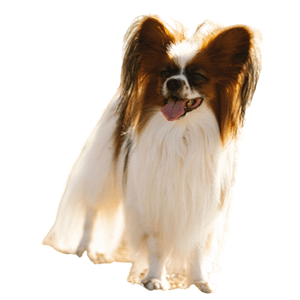Papillon

“The Papillon is the French name for butterfly; the face and ears of little canines resemble this. The Papillon has roots in the dwarf spaniels so famous all through Europe from at least the 16th century. These little puppies were extraordinarily famous with the nobility; as time went on, Spain and Italy became the dwarf spaniel breeding and trading centers. The court of Louis XIV of France was especially fond of those little puppies and imported lots of them. The Papillon was referred to as the Squirrel Spaniel because the plumed tail was carried over the back as a squirrel does. These early puppies had drooping ears; however, a few puppies sported erect ears through some unknown event. Both drop- and erect-eared Papillons can be observed in the same litter. Even nowadays, each ear kinds are equally correct, although the erect-eared canine is more popular.
In the USA, the drop-eared Pap is called the Phalene, a French word for a moth, while in Europe, it is referred to as the Epagneul Nain or Continental Toy Spaniel. The Papillon has become one of the more famous toy puppies, functioning similarly well as a loving pet, stunning show canine, and skilled obedience and agility competitor.”
- Type - Toy
- Weight -4-9 lb
- Height- 8-11"
- Family -Spaniel, Companion
- Date of Orgin-1500s
- Area of Orgin -France
- Other Names -Epagneul Nain, Phalene, Continental Toy Spaniel
Energy Level
Exercise Requirements
Playfulness
Affection Level
Friendliness To Dogs
Friendliness To Other Pets
Friendliness To Strangers
Watchfulness
Ease of Training
Grooming Requirements
Heat Sensitivity
Vocality
Temperement
One of the most responsive and obedient toy breeds, the vivacious Papillon is a gentle, amiable, and playful training dog. The breed is friendly toward strangers, different dogs, and pets. The canine is superb with youngsters; however, because of the small size may be injured by rough play. Some may be timid.
Upkeep
The energetic Papillon flourishes on mental stimulation, and enjoys an everyday stroll on leash in addition to challenging games interior or out. The coat desires brushing two times weekly.
Health
“Major diagnosis: none
Minor diagnosis: patellar luxation, seizures, dental problems
Occasionally seen: vWD, PRA, open fontanel, intervertebral disk disease, allergies
Suggested tests: knee, eye, (vWD), cardiac
Life span: 12–15 years”
Disclaimer
Note: While the characteristics mentioned here may frequently represent this breed, dogs are individuals whose personalities and appearances will vary. Please consult the adoption organization for details on a specific pet.
